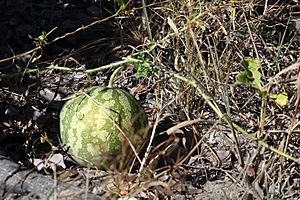Namib tsamma facts for kids
Quick facts for kids Namib tsamma |
|
|---|---|
 |
|
| Scientific classification | |
| Genus: |
Citrullus
|
| Species: |
ecirrhosus
|
| Synonyms | |
|
|
Citrullus ecirrhosus, often called Namib tsamma, is a special kind of perennial plant. It is a desert vine from the gourd family, Cucurbitaceae. This plant is a close relative of the watermelon (Citrullus lanatus) that many people enjoy eating. You can find the Namib tsamma growing in the dry lands of Namibia and South Africa, especially in the Namib Desert. It is also related to the bitter melon, Citrullus amarus. Both of these plants have hard, white, and bitter flesh inside their fruits.
Contents
About the Namib Tsamma Plant
The Namib tsamma plant has long vines that can spread up to two meters across the ground. It also grows bright yellow flowers. Since it lives in the desert, this plant is very tough. It can survive with very little water and under strong sunlight. Each year, new stems with leaves grow, and then they die back. The plant gets its water from deep in the ground and from the morning fogs that roll in. The fruit it produces is bitter and is known as a tsamma melon.
How It Survives in the Desert
The Namib tsamma is amazing at living in harsh desert conditions. It has special ways to find and keep water.
- It sends its roots deep into the ground to reach underground water sources.
- It uses the moisture from morning fogs, which is very important in the dry desert.
- Its leaves and stems are designed to handle intense sunlight and heat.
Importance for Desert Animals
The tsamma melon is a very important source of water for many animals living in the desert. When other water sources are scarce, these melons provide essential moisture. This helps different desert creatures stay hydrated and survive.
Helping Watermelons Grow Stronger
Scientists have done interesting experiments with the Namib tsamma. In 2019, researchers like Simmons, Jarret, Cantrell, and Amnon tried something new. They mixed Citrullus ecirrhosus with the common watermelon (Citrullus lanatus). This process is called hybridization.
Developing Pest Resistance
The goal of this experiment was to create a new type of watermelon. This new watermelon would be able to fight off pests better. One common pest is the whitefly (Bemisia tabaci). These tiny insects can cause a lot of damage to watermelon crops.
The hybrid watermelon they created showed good resistance to whiteflies. While it didn't completely stop all whiteflies, it was much better protected than regular watermelons. This means that the tough traits of the Namib tsamma could help make our favorite watermelons stronger and healthier.
Images for kids
See also
 In Spanish: Namib tsamma para niños
In Spanish: Namib tsamma para niños



